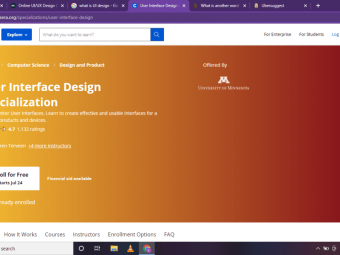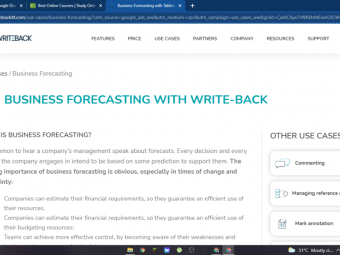University Level Introduction To Financial Accounting
Tags: Financial Accounting
Learn the Basics of Financial Accounting: Financial Statements, Debits and Credits, The Accounting Cycle and More!
Last updated 2022-01-10 | 4.4
- Understand the Accounting Equation and the Debit/Credit System.- Identify All Stages of The Accounting Cycle.
- Measure
- Value and Re-value Assets
- Liabilities and Equity.
What you'll learn
* Requirements
* English* Arithmetic
* Basic Algebra
Description
Welcome to the Financial Accounting Crash Course.
This course will provide you with 69 video lessons that span over 10 hours of content (including quizzes to help test your knowledge). Follow along as I explain the basics about assets, liabilities and equity, along with fundamental concepts like the accounting equation, debits and credits, the accounting cycle, financial statements and more!
Financial accounting is the language of business. In business, we use financial accounting to report everything we do. Whether it’s paying our employees, issuing a dividend to shareholders or purchasing a capital asset, we report it. Bookkeeping ensures that we have a history of every economic activity. Summarizing all of these transactions into financial statements provides us with a general snapshot of our performance and position in the marketplace. Having this financial information at our fingertips is key to future planning and decision making.
The first part of the crash course will cover:
Basics of Financial Accounting
Assets, Liabilities and Equity
Debits and Credits and The Double Entry Accounting System
The Accounting Cycle, including: Journal Entries, T-accounts, General Ledger, Trial Balance Statements, Adjusting Entries, Adjusted Trial Balance Statements, and Closing Entries
The second part of the crash course will cover:
Merchandise Inventory: Perpetual and Periodic Systems
Inventory Costing Systems: FIFO, Weighted-average, LIFO
Receivables and Bad Debts
Revenue Recognition
Depreciation and Amortization
Intangible Assets
The Cash Flow Statement: Indirect Method
**BONUS: Financial Accounting final exam downloadable .PDF now included at the end of the course!**
HERE'S WHAT SOME STUDENTS OF HAVE TOLD ME ABOUT MY COURSE:
"The Notepirate videos got me through Acct 101 with a 97%. I've always found your videos easy to understand and well-paced." - Alan P.
"Hello Dave, just wanted to say thank you! Your videos helped my classmates and I tremendously. We did very well. 95%, 90%, 86%, 85%. Thanks again!" - Ariel S.
"Hey Dave. I'm also reviewing in order to become a CPA. Your videos are absolutely brilliant. I have never seen the business activities presented in such a manner... but I will remember this model for a lifetime now. Thank you so much for taking the time to record these videos. You truly are making a huge difference and impact on the world. Cheers..." - Sarah B.
Who this course is for:
- College Students
- University Students
- High School Students
- Potential CPA Test Takers
- Bookkeepers
- Small Business Owners
- Accountants
- Managers
Course content
12 sections • 88 lectures
What is Financial Accounting? Preview 09:27
WHAT YOU WILL LEARN:
What Financial Accounting is, and why we need financial accounting information in our global economy.
HOW IT WILL APPLY LATER ON:
Understanding what financial accounting is, and why we prepare financial accounting information is imperative to your success in the course. You should memorize my three-step definition of financial accounting to relate everything we learn back to this.
What is Financial Accounting
This quiz should be taken after watching the What is Financial Accounting video tutorial.
Structures of a Business Preview 09:28
WHAT YOU WILL LEARN:
An introduction to the three different types of business structures: Sole-proprietorship, Partnership, and a Corporation. We'll go over the basics of each like the number of owners, the amount of liability you're exposed to, potential profitability, and tax implications.
HOW IT WILL APPLY LATER ON:
Understanding different business structures will help you make sense of the business world. Knowing the benefits and disadvantages of structuring a business is very important for entrepreneurs, tax planners and accountants.
Structures of a Business Quiz
Internal vs. External Users of Accounting Information Preview 07:38
WHAT YOU WILL LEARN:
The difference between internal and external users. I'll provide examples that will help you identify and sort which are internal and external.
HOW IT WILL APPLY LATER ON:
We know that financial accounting is about preparing financial information for users to aid them in their decision making. When we prepare financial statements, we should look to cater the financial information to external users so that they're understandable, easily comparable (to other companies financial statements) and consistent from period to period. Knowing which users we're preparing financial accounting information for is highly relevant.
Internal vs. External Users of Accounting Information Quiz
Business Activities: Operating, Investing and Financing Preview 09:04
WHAT YOU WILL LEARN: How every business is engaged in three primary business activities: operating, investing and financing activities. See how business activities interact with Balance Sheet accounts and learn a nifty acronym for upcoming tests!
HOW IT WILL APPLY LATER ON:
As we begin to prepare financial statements, you'll come across the Cash Flow Statement. Everything on the Cash Flow Statement is categorized by business activities. Don't expect to pass Financial Accounting or become an Accountant if you don't understand business activities!
Business Activities Quiz
This quiz should be taken after the Business Activities: Operating, Investing and Financing Activities Tutorial.
What are Financial Statements and the Types of Financial Statements Preview 13:01
WHAT YOU WILL LEARN: After this tutorial you'll have an idea of the financial statements that are commonly prepared within financial accounting. We'll cover the Income Statement, The Retained Earnings Statement, The Balance Sheet and The Cash Flow Statement. Understand how the financial statements are interconnected, and the purpose of each one.
HOW IT WILL APPLY LATER ON:
Financial statements are prepared on a monthly, quarterly and annual basis by accountants. Becoming familiar with these standardized statements will help you when we begin discussing how to prepare them.
What are the Financial Statements Quiz
Elements of Financial Accounting Preview 05:28
WHAT YOU WILL LEARN: Accounting elements are the language of financial accounting. Without them it would be like trying to communicate without words. Remarkably, every transaction in financial accounting affects at least one of the nine accounting elements. Understand their importance in this tutorial!
HOW IT WILL APPLY LATER ON:
Financial accounting elements are affected by every transaction. If you don't understand them, you'll have difficulty preparing transactions, let alone financial statements or financial accounting information.
Elements of Financial Accounting Quiz
What is an Asset? Preview 14:14
WHAT YOU WILL LEARN: Understand the criteria that needs to be met to recognize an asset. Improperly recording an asset as a liability or an asset as a revenue can have grave consequences. Join us as we go through some examples of assets!
HOW IT WILL APPLY LATER ON:
Understanding how to identify which transactions affect which accounting elements is key to preparing financial accounting information. In financial accounting, we want to capture the true economic activity taking place. Having correct numbers and accounts are key to preparing fair financials.
What is a Liability? Preview 07:48
WHAT YOU WILL LEARN:
We'll go over the definition of a liability and explain why certain transactions will generate liability accounts.
HOW IT WILL APPLY LATER ON:
Understanding how to recognize a liability is key within Financial Accounting. Every transaction affects either an asset, liability or an equity account. By correctly identifying that a transaction involves a liability, you'll be one step closer to preparing journal entries! (Journal entries are the beginning of basic bookkeeping).
What is Equity? Preview 09:24
WHAT YOU WILL LEARN:
We'll go over the definition of equity and how it relates to assets and liabilities. Using an example, we'll see how equity changes based on the number of owners or asset price fluctuations.
HOW IT WILL APPLY LATER ON:
Many students breeze through this fundamental accounting element without fully understanding it, which normally leads to errors later in the course.
This tutorial will prepare you for:
- Journal entries involving equity accounts
- The Statement of Changes in Equity
What is a Equity? Quiz
The Financial Accounting Equation Preview 08:00
WHAT YOU WILL LEARN:
We'll discuss the accounting equation and the logic behind why all transactions must make use of it. To guide students, I will post a few rules that you'll need to follow, and will demonstrate a couple of examples to reinforce the concept.
HOW IT WILL APPLY LATER ON:
The accounting equation is simply one of the most important concepts in financial accounting. Every transaction will need to be entered correctly in order to have reliable financial information.
The Financial Accounting Equation Quiz
Financial Accounting Conceptual Framework Preview 09:52
WHAT YOU WILL LEARN:
Steering clear of fraud should be a top priority for all accountants. The conceptual framework of financial accounting provides us with the guidance to prepare and present financial information fairly. Join us as we break down the concept using an analogy and a fun Christmas tree example.
HOW IT WILL APPLY LATER ON:
One of the most important aspects of the conceptual framework of financial accounting is GAAP (Generally Accepted Accounting Principles). Understanding the basics of the conceptual framework system will provide you with a strong foundation to begin discussing accounting principles like revenue recognition, materiality and the matching principle.
The Double Entry Accounting System Preview 05:18
WHAT YOU WILL LEARN:
Every transaction must have two entries, a debit and a credit. The Double-Entry Accounting System has been used for ages and is vital for the preparation of financial accounting information.
HOW IT WILL APPLY LATER ON:
Understanding which account to debit and credit is paramount to transaction analysis and journalizing entries.
The Double Entry Accounting System Quiz
Debits and Credits for Financial Accounting Preview 08:32
WHAT YOU WILL LEARN:
This tutorial will provide you with the know-how to decide whether an account should be debited or credited. We'll look at the accounting equation to understand the logic behind the debit/credit system so that you won't have to memorize anything!
HOW IT WILL APPLY LATER ON:
Understanding which account to debit and credit is paramount to transaction analysis and journalizing entries.
Normal Account Balances and RED (Revenue, Expense, Dividends) Accounts Preview 07:33
WHAT YOU WILL LEARN:
After going over the debit/credit system, I thought a normal balance tutorial would help those that are struggling with the concept. We'll go over a bunch of different asset, liability and equity accounts and see the normal balances of each, including the super special RED accounts: revenue, expenses, and dividends.
HOW IT WILL APPLY LATER ON:
Understanding which account to debit and credit is paramount to transaction analysis and journalizing entries.
Journal Entries and The Accounting Cycle Preview 09:15
WHAT YOU WILL LEARN:
In this lesson we'll discuss the Accounting Cycle and provide a general overview of the process used by companies to analyze transactions, report them, and summarize them into general-purpose financial statements.
This first lesson in the segment will focus on transaction analysis and journal entries.
HOW IT WILL APPLY LATER ON:
The Accounting Cycle is a fundamental concept in Financial Accounting that covers all reporting elements from beginning to end of an accounting period. Journal entries (this lesson) are a core component of the Accounting Cycle. It's important that you analyze the transaction/event and debit/credit the correct accounts.
Journal Entries and The Accounting Cycle Quiz
This quiz should be taken after the Journal Entries and The Accounting Cycle Tutorial.
General Ledger, T Accounts and The Accounting Cycle Preview 08:40
After this tutorial you'll be able to create a fully working general ledger that houses all of the accounts for a company. The general ledger is the overview of all accounts used in a company and their respective balances.
General Ledger, T Accounts and The Accounting Cycle Quiz
This quiz should be taken after the General Ledger, T Accounts and The Accounting Cycle video tutorial.
Trial Balance Statement and The Accounting Cycle Preview 07:19
The trial balance is our first checkpoint that confirms whether or not the majority of our entries are correct. A trial balance that displays debits not equaling credits is a red flag. Learn to compile a trial balance statement now!
Trial Balance Statement and The Accounting Cycle Quiz
This quiz should be taken after the Trial Balance Statement and The Accounting Cycle video tutorial.
Adjusting Entries for Accrued Expenses Preview 12:03
WHAT YOU WILL LEARN:
In the next few lessons we'll continue on with the accounting cycle and learn about accrued expense adjusting entries. Understand the purpose of adjusting entries along with a few simple rules that will guide you.
HOW IT WILL APPLY LATER ON:
Adjusting entries are a super important concept in financial accounting. Because companies often use the accrual basis of accounting instead of the cash basis, we'll need to report revenue and expenses when they occur. Adjusting entries are used for that exact purpose. You should understand by the end of the lesson how adjusting entries are used to comply with the matching principle under GAAP.
Adjusting Entries for Accrued Expenses Quiz
This quiz should be taken after the Adjusting Entries for Accrued Expenses video tutorial.
Adjusting Entries for Prepaid Expenses Preview 05:24
If you lease an office, there might be a chance that you prepaid the rent for an entire year. Learn how to use adjusting entries to delay the recognition of expenses until until the asset is "used."
Adjusting Entries for Prepaid Expenses Quiz
This quiz should be taken after the Adjusting Entries for Prepaid Expenses video tutorial.
Adjusting Entries for Unearned Revenues Preview 06:48
In this tutorial we learn how to create an adjusting entry for unearned revenue using subscription cash that was collected in advance. The adjusting entry will debit the unearned revenue account (liability) and credit the revenue account as we earn the revenue. Remember that adjusting entries never involve cash and that we adjust accounts at the end of an accounting period which is the month end.
Adjusting Entries for Unearned Revenues Quiz
This quiz should be taken after the Adjusting Entries for Unearned Revenues video tutorial.
Adjusting Entries for Accrued Revenue Preview 05:22
Revenues aren't just about receiving cash. Revenues are reported when we have a claim to cash in the future via the account, accounts receivables. Learn how to accrue revenue when performing adjusting entries.
Adjusting Entries for Accrued Revenue Quiz
This quiz should be taken after the Adjusting Entries for Accrued Revenue video tutorial.
Adjusting Entries for Amortization and Depreciation Preview 09:46
Amortization and depreciation isn't about trying to find the decline in value of a certain asset. It's to show the allocation of cost over the asset's useful life. Learn about the difference between the terms "depreciation" and "amortization" while we report for each.
Prepare an Adjusted Trial Balance Statement Preview 09:59
Learn how to update your original trial balance statement by factoring in adjusting entries and preparing your adjusted trial balance statement!
Preparing the Financial Statements Preview 09:47
Remember when we went over some of the general financial statements you'll encounter in financial accounting? Well today we get to prepare them! Join us as we go through the income statement, retained earnings statement and the balance sheet.
Permanent Vs. Temporary Accounts Preview 05:27
Some accounts that we use within financial accounting will be permanent (real) or temporary (nominal). Learn how to differentiate between the two and why only certain accounts are temporary.
How To Prepare Closing Entries Preview 08:26
We're closing up the books! Join us as we close the temporary accounts that exist on our books and transfer the balances to permanent (real) accounts. After this you can say you've studied the accounting cycle!
Introduction to Merchandise Inventory Preview 06:50
Inventory is the heart of many corporations including, Walmart, Costco and other retail corporations. Receive an introduction to our chapter on merchandise inventory!
Perpetual Vs. Periodic Inventory System Preview 07:03
A quick comparison between the perpetual and periodic inventory system. This is important before we learn to account for transactions in a perpetual or periodic system, so make sure to watch!
Perpetual Inventory System and How to Journalize Purchase Entries Preview 10:28
After watching this tutorial you'll be equipped with the ability to report purchase transactions on the books of your company (if it uses a perpetual system).
Perpetual Inventory System Sales Entries Preview 09:42
After watching this tutorial you'll be equipped with the ability to report sales transactions on the books of your company (if it uses a perpetual system).
Prepare a Multiple Step Income Statement Preview 10:20
The multiple-step income statement is the standard for preparing an income statement. It has a line that displays the cost of goods sold so that we can establish our gross profit margin. Learn how to prepare a multiple-step income statement!
Purchase Journal Entries for the Periodic Inventory System Preview 06:43
After watching this tutorial you'll know how to report purchases on the books of a company that uses a periodic inventory system.
Periodic Inventory System and the Multiple Step Income Statement Preview 09:46
We tie the periodic inventory system together with the multiple-step income statement in this tutorial. Can you spot any differences between the way the multiple-step income statement is prepared under the perpetual system versus the periodic system?
Specific Identification Method and Expensing Inventory Preview 05:40
The specific identification method tracks each item that is sold rather than using any cost flow assumption (like FIFO or Average Cost..which we will soon learn about!). This method is normally used for a small number of highly costly, easily distinguishable items.
FIFO Method, First in First Out Method for Expensing Inventory Preview 10:56
The FIFO or first-in-first-out method is a cost assumption used to expense our merchandise inventory. Learn how to attribute cost to items that are sold and how FIFO may affect our cost of goods sold figure that is super important to investors and users!
Weighted Average Cost Flow Method for Expensing Inventory Preview 09:29
The average cost or weighted average cost method is a cost assumption used to expense our merchandise inventory. Learn how to attribute cost to items that are sold and how the average cost method may affect our cost of goods sold and ending inventory figure!
LIFO Method, Last in First Out Method for Expensing Inventory Preview 10:46
LIFO or last-in-first-out is becoming an obsolete cost flow method. It is PROHIBITED under IFRS standards (companies that are public and on a stock exchange) and is only permitted under US GAAP. Learn about this method and why its use is diminishing.
Prepare the Average Cost Method for a Perpetual Inventory System Preview 07:38
Using the weighted average cost flow method is a bit different under the perpetual inventory system. We'll have to create a moving average when calculating our cost of goods sold and ending inventory. Learn about it in this tutorial!
Analyzing the Cost Flow Assumptions: FIFO, Average Cost, LIFO Methods Preview 08:50
This is a MUST WATCH tutorial that compares the different inventory cost flow methods. It shows how cost of goods sold or ending inventory might differ based on an inflationary or deflationary economic environment. Learn this to master your theory on inventory!
Intro to the Allowance Method and Uncollectible Accounts Preview 06:09
This is the introduction to the allowance method. The allowance method is used for receivables that are likely uncollectible. The allowance method provides us with an opportunity to show the expense in the correct period (matching principle) while retaining an accurate net realizable value of receivable.
Allowance for Doubtful Accounts Part 2 Preview 06:55
This is an expansion on the topic of the allowance method. It'll provide you with the fundamentals before we can apply the sales and receivables method to report uncollectibles.
Sales Method for Estimating Bad Debts Expense Preview 08:08
The sales method is one method to recognize bad debts expense. Using an estimated percent, we'll write off a certain amount of collections (normally it's low at 1,2,3%). This is super useful since many companies use the percentage-of-sales method to report uncollectible receivables!
Percentage of Receivables Method for Bad Debts Expense Preview 08:22
The receivables is the second method that we may use to recognize bad debts expense. In this tutorial we'll show how to apply the receivables method since it is a bit more complicated than the percentage-of-sales method.
Aging Table and Percentage of Receivables Method Part 2 Preview 06:46
Aging tables are commonly used when accounting for bad debts using the percentage-of-receivables method. An aging table lists all receivables and stratifies them based on their age (older receivables being less likely to collect). Based on the amount of receivables that we expect to be uncollectible will affect our bad debts expense figure. This tutorial should help you master the percentage-of-receivables method.
Write Off Receivables Using the Allowance Method Preview 07:00
In this video we simply look at the write off of uncollectibles after a bad debts expense and allowance for doubtful accounts account has been reported. This tutorial will equip you with the ability to write off uncollectibles and reverse any mistakes or uncollectibles that become collectible.
Direct Write Off Method for Receivables Preview 08:17
The direct write off method is used by small shops or companies when they decide that the allowance method is too complex for their books. This method is simple but flawed when reporting and accruing bad debts expense and uncollectibles.
Revenue Recognition Principle for Accrual Based Accounting Preview 07:59
This video is SUPER important since revenue recognition is one of the most important concepts. Companies that have used bad judgement with respect to revenue recognition have been known to collapse (Enron). Join us as we go through a tutorial that begs the question, when should we recognize revenue?
Revenue Recognition Examples: Consignment, Criteria, Long Term Contracts Preview 08:04
After going over the criteria for recognizing revenue, I've decided to bring up three (difficult) examples where revenue recognition might be questionable (as to when it should happen). After this tutorial you should have a sound understanding of when to recognize revenue.
Summary of Percentage of Completion, Cost Recovery,Completed Contract Methods Preview 09:27
When should we recognize revenue if we are in the middle of a 20 year construction (condominium) project? Normally the answer is gradually over the period. Join us as we look at a summary of methods we may use for recognizing revenue for long term contracts.
Percentage of Completion Method for Long Term Contracts Preview 09:53
In this video you'll learn how to account for a long term contract using the percentage-of-completion method for recognizing revenue. This method is used under IFRS and is standard for long term contracts. Come out of this tutorial understanding one of the most common methods for reporting long term contracts.
NOTE: There is a transpositional error in this tutorial where the revenue to date (@4:25) should be $3,528,000 and not $3,582,000.
If you follow the logic and flow of the tutorial you should still understand the percentage of completion method for long term contracts. :)
Percentage of Completion Method for Long Term Contracts Quiz
Percentage of Completion Method Journal Entries Preview 12:25
After this tutorial you should have an understanding of how to record journal entries pertaining to a long term contract that uses the percentage-of-completion method.
NOTE: There is a transpositional error (from the first percentage of completion tutorial) in this tutorial where the revenue to date should be $3,528,000 and not $3,582,000.
Percentage of Completion: Journalize Losses in Period and on Contracts Preview 11:13
Normally we expect a gross profit year-to-year on our long term contract. What happens if we incur a loss? Or a loss on the entire contract? Watch this video to prepare for the worst!
NOTE: There is a transpositional error (from the first percentage of completion tutorial) in this tutorial where the revenue to date should be $3,528,000 and not $3,582,000.
Cost Recovery Method and Deferred Income Preview 09:37
The cost recovery method is an alternative to the percentage-of-completion method when the percentage-of-completion method is inappropriate to use. This method reports all revenues and expenses but defers all income until total cash receipts have exceeded costs. Learn this alternate method now!
Completed Contract Method Explanation and Journal Entries Preview 04:51
The completed-contract method is still a valid method used under ASPE or PE GAAP. It is PROHIBITED under IFRS. The completed-contract method is super conservative in that it reports no revenues, expenses or gross profit until the contract is complete.
Completed Contract Method and Losses in a Period and on Contract Preview 04:41
Normally we expect a gross profit year-to-year on our long term contract. What happens if we incur a loss? Or a loss on the entire contract? Watch this video to prepare for the worst under the completed-contract method!
Depreciation, Amortization, and Depletion Explanation Preview 07:20
What is depreciation or amortization? It most certainly is reported on almost EVERY financial statement issued by a company. Learn about this concept before we head into some calculations!
Straight Line and Declining Balance Method Preview 13:03
Get ready to learn the straight-line and the declining balance method for recognizing depreciation or amortization expense. This should prep you for the next tutorial we have which will involve some calculations!
Straight Line and Double Declining Balance Depreciation Example Preview 08:37
We'll go over some examples in this tutorial for calculating depreciation expense using the straight-line or declining balance method. This follow up tutorial is perfect for getting ready for a test that includes the topic of depreciation.
Gains and Losses on Disposal of Property, Plant and Equipment Preview 07:56
What happens when we decide to get rid of a long lived asset like a car or property? What if it's something smaller like a piece of equipment? Well depending on the proceeds ($) you receive will determine whether or not you might have to report a gain or a loss! Perfect for students and those reporting financials!
NOTE: The question should state July 31,2015 in the video instead of July 31, 2014.
Accounting for Intangible Assets Preview 09:12
Intangible assets can be some of the largest and most valuable assets on a company's books. We'll introduce you to the topic of intangibles and provide you with examples of some like logos, trademarks, copyrights etc!
Amortizing Intangible Assets and Presentation Preview 17:02
If you've made it this far you should understand how to depreciate a physical capital asset. It only makes sense that we help you understand how to amortize intangible assets. Go over some examples with us to get prepared for a question like this on a test!
Impairment of Intangible Assets Preview 09:45
Just like any asset, intangible assets can become impaired. When do we report an impairment charge and how do we report it? It's all covered in this tutorial!
You can also credit the Accumulated Amortization (patent) account instead of just Patent when there is an impairment loss. Both will provide an accurate net book value @5:38.
Recording Goodwill, Amortization and Impairment Preview 09:26
Many students struggle with the concept of goodwill. We've decided to simplify it into a quick 10 minute tutorial that will teach you the basics of this asset.
Preparing a Cash Flow Statement using Indirect Method: Part 1 Preview 07:08
Are you up to the challenge of mastering the cash flow statement? When you're ready we'll start a six part series that covers how to prepare a cash flow statement using the indirect method. After this section you should be well ahead of the curve.
Preparing a Cash Flow Statement using the Indirect Method Quiz
This quiz should be taken after watching the Preparing a Cash Flow Statement using Indirect Method: Part 1 tutorial.
Cash Flow Statement using Indirect Method: Part 2, Receivables Preview 10:14
We'll provide you with tips and tricks to preparing a cash flow statement in this tutorial. Afterwards we'll look at one of the first items we'll adjust for which is accounts receivables. Learn the simple way by using our tutorial to master the cash flow statement.
NOTE: I accidentally wrote "Use +" for CL decreases when it should be "Use (-)," my apologies!
Cash Flow Statement using the Indirect Method: Part 3, Inventory Preview 04:07
If you thought the last tutorial was incredibly easy, wait until you watch this one. We'll summarize how to adjust for changes in inventory and cover part three of the indirect cash flow statement. Keep it up, you're half way to mastering the cash flow statement!
Cash Flow Statement using Indirect Method: Part 4, Payables Preview 04:11
Accounts payables and other payables have to be adjusted for since they are an accrual account. We illustrate with ease how to adjust for them and why we adjust for them the way we do.
Cash Flow Statement using Indirect Method: Part 5, Non Cash Expenses Preview 04:54
After adjusting for all working capital (current) accounts we can move on to adding back non-cash expenses. This should be the easiest tutorial of our cash flow statement series
Cash Flow Statement: Investing and Financing Activities Preview 08:54
You've made it! This last tutorial will let you complete the investing and financing sections of your indirect cash flow statement. Congratulations, you should now be able to prepare cash flow statements on your midterms, tests or final exams. Thanks for watching our introductory to financial accounting course.








 This course includes:
This course includes:
















